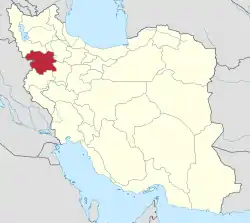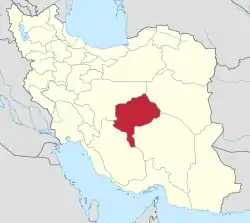Provinces of Iran
Iran is subdivided into thirty-one provinces (Persian: استان Ostān), each governed from a local centre, usually the largest local city, which is called the capital (Persian: مرکز, markaz) of that province. The provincial authority is headed by a Governor-general[1] (Persian: استاندار Ostāndār), who is appointed by the Minister of the Interior subject to approval of the cabinet.
| Provinces of Iran استانهای ایران (in Persian) | |
|---|---|
| Also known as: Ostān استان | |
 | |
| Category | Unitary state |
| Location | Iran |
| Number | 31 |
| Populations | 580,158 (Ilam Province) – 13,267,637 (Tehran) |
| Areas | 5,833 km2 (2,252 sq mi) (Alborz) – 183,285 km2 (70,767 sq mi) (Kerman Province) |
| Government | Provincial government (National government) |
| Subdivisions | County |


.svg.png.webp)
Legend:


Modern history
Iran has held its modern territory since the Treaty of Paris in 1857. From 1906 until 1950, Iran was divided into twelve provinces: Ardalan, Azerbaijan, Baluchestan, Fars, Gilan, Araq-e Ajam, Khorasan, Khuzestan, Kerman, Larestan, Lorestan, and Mazandaran.[2]
In 1950, Iran was reorganized to form ten numbered provinces with subordinate governorates: Gilan; Mazandaran; East Azerbaijan; West Azerbaijan; Kermanshah; Khuzestan; Fars; Kerman; Khorasan; Isfahan.[2]
From 1960 to 1981 the governorates were raised to provincial status one by one. Since then several new provinces have been created, most recently in 2010 when the new Alborz Province was split from Tehran province, and before that in 2004 when the province of Khorasan was divided into three provinces.[3]

Information
.png.webp)

Current provinces
| Province | Capital | Area[4] | Population[5] | Density | Shahrestans (counties) | Life expectancy, male[6] | Life expectancy, female[6] | Notes | Map |
|---|---|---|---|---|---|---|---|---|---|
| Alborz | Karaj | 5,833 km2 (2,252 sq mi) | 2,712,400 | 413.6/km2 (1,071/sq mi) | 4 | 74.4 | 78 | Until 23 June 2010, Alborz was part of Tehran province. |  |
| Ardabil | Ardabil | 17,800 km2 (6,900 sq mi) | 1,270,420 | 70.1/km2 (182/sq mi) | 9 | 71.3 | 75.6 | Until 1993, Ardabil was part of East Azerbaijan province.[7] |  |
| Azerbaijan, East | Tabriz | 45,650 km2 (17,630 sq mi) | 3,909,652 | 82.3/km2 (213/sq mi) | 19 | 72.5 | 75.9 |  | |
| Azerbaijan, West | Urmia | 37,437 km2 (14,455 sq mi) | 3,265,219 | 78.8/km2 (204/sq mi) | 14 | 71.6 | 76.3 | During the Pahlavi Dynasty Urmia was known as Rezaiyeh.[8] |  |
| Bushehr | Bushehr | 22,743 km2 (8,781 sq mi) | 1,163,400 | 45.4/km2 (118/sq mi) | 9 | 71 | 73.5 | Originally part of Fars province. Until 1977, the province was known as Khalij-e Fars (Persian Gulf).[2] |  |
| Chahar Mahaal and Bakhtiari | Shahrekord | 16,332 km2 (6,306 sq mi) | 947,763 | 54.8/km2 (142/sq mi) | 6 | 70.2 | 75 | Until 1973 was part of Isfahan province.[9] |  |
| Fars | Shiraz | 122,608 km2 (47,339 sq mi) | 4,851,274 | 37.5/km2 (97/sq mi) | 23 | 72.1 | 76.3 |  | |
| Gilan | Rasht | 14,042 km2 (5,422 sq mi) | 2,530,696 | 176.7/km2 (458/sq mi) | 16 | 72.1 | 76.5 |  | |
| Golestan | Gorgan | 20,195 km2 (7,797 sq mi) | 1,868,819 | 88.0/km2 (228/sq mi) | 11 | 70.8 | 74.2 | On the 31 May 1997, the shahrestans of Aliabad, Gonbad-e-kavus, Gorgan, Kordkuy, Minudasht, and Torkaman were separated from Mazandaran province to form Golestan province. Gorgan was called Esteraba or Astarabad until 1937.[2] |  |
| Hamadan | Hamadan | 19,368 km2 (7,478 sq mi) | 1,738,234 | 90.8/km2 (235/sq mi) | 8 | 71.2 | 75.6 | Originally part of Kermanshah province.[2] |  |
| Hormozgān | Bandar Abbas | 70,669 km2 (27,285 sq mi) | 1,776,415 | 22.3/km2 (58/sq mi) | 11 | 69.9 | 73.7 | Originally part of Kerman province.[2] Until 1977, the province was known as Banader va Jazayer-e Bahr-e Oman (Ports and Islands of the Sea of Oman).[2] |  |
| Ilam | Ilam | 20,133 km2 (7,773 sq mi) | 580,158 | 27.7/km2 (72/sq mi) | 7 | 70.5 | 72 | Originally part of Kermanshah province.[2] |  |
| Isfahan | Isfahan | 107,029 km2 (41,324 sq mi) | 5,120,850 | 45.6/km2 (118/sq mi) | 21 | 73 | 77 | In 1986, some parts of Markazi province were transferred to Isfahan, Semnan, and Zanjan provinces.[2] |  |
| Kerman | Kerman | 183,285 km2 (70,767 sq mi) | 3,164,718 | 16.3/km2 (42/sq mi) | 14 | 71.4 | 75.5 |  | |
| Kermanshah | Kermanshah | 24,998 km2 (9,652 sq mi) | 1,952,434 | 77.8/km2 (202/sq mi) | 13 | 70.4 | 75.3 | Between 1950 and 1979, both Kermanshah province and city were known as Kermanshahan and between 1979 and 1995 were known as Bakhtaran.[2] |  |
| Khorasan, North | Bojnourd | 28,434 km2 (10,978 sq mi) | 863,092 | 30.5/km2 (79/sq mi) | 6 | 69.8 | 72.6 | On 29 September 2004, Khorasan was divided into three provinces. North Khorasan; Razavi Khorasan; South Khorasan.[3] |  |
| Khorasan, Razavi | Mashhad | 118,884 km2 (45,901 sq mi) | 6,434,501 | 41.4/km2 (107/sq mi) | 29 | 72.1 | 76.2 | On 29 September 2004, Khorasan was divided into three provinces. North Khorasan; Razavi Khorasan; South Khorasan.[3] |  |
| Khorasan, South | Birjand | 151,913 km2 (58,654 sq mi) | 768,898 | 9.5/km2 (25/sq mi) | 8 | 70.8 | 73.9 | On 29 September 2004, Khorasan was divided into three provinces. North Khorasan; Razavi Khorasan; South Khorasan.[3] |  |
| Khuzestan | Ahvaz | 64,055 km2 (24,732 sq mi) | 4,710,509 | 67.8/km2 (176/sq mi) | 18 | 71.3 | 73.9 |  | |
| Kohgiluyeh and Boyer-Ahmad | Yasuj | 15,504 km2 (5,986 sq mi) | 713,052 | 42.5/km2 (110/sq mi) | 5 | 71.2 | 73.1 | Originally part of Khuzestan province. Until 1990, the province was known as Bovir Ahmadi and Kohkiluyeh.[2] |  |
| Kurdistan | Sanandaj | 29,137 km2 (11,250 sq mi) | 1,603,011 | 51.3/km2 (133/sq mi) | 9 | 70.6 | 74.1 | Originally part of Gilan province.[2] |  |
| Lorestan | Khorramabad | 28,294 km2 (10,924 sq mi) | 1,760,649 | 62.0/km2 (161/sq mi) | 9 | 71.1 | 74.5 | Originally part of Khuzestan province.[2] |  |
| Markazi | Arak | 29,130 km2 (11,250 sq mi) | 1,429,475 | 48.5/km2 (126/sq mi) | 10 | 72.9 | 76.7 | Originally part of Mazandaran province.[2] In 1986, some parts of Markazi province were transferred to Isfahan, Semnan, and Zanjan provinces.[2] |  |
| Mazandaran | Sari | 23,701 km2 (9,151 sq mi) | 3,283,582 | 129.7/km2 (336/sq mi) | 15 | 73.5 | 77 |  | |
| Qazvin | Qazvin | 15,549 km2 (6,004 sq mi) | 1,273,761 | 77.3/km2 (200/sq mi) | 5 | 71.8 | 75.3 | On 31 December 1996, the shahrestans of Qazvin and Takestan were separated from Zanjan province to form the province of Qazvin.[2] |  |
| Qom | Qom | 11,526 km2 (4,450 sq mi) | 1,292,283 | 99.9/km2 (259/sq mi) | 1 | 71.5 | 75.6 | Until 1995, Qom was a shahrestan of Tehran province.[2] |  |
| Semnan | Semnan | 97,491 km2 (37,641 sq mi) | 702,360 | 6.5/km2 (17/sq mi) | 4 | 73.2 | 76.1 | Originally part of Mazandaran province.[2] In 1986, some parts of Markazi province were transferred to Isfahan, Semnan, and Zanjan provinces.[2] |  |
| Sistan and Baluchestan | Zahedan | 180,726 km2 (69,779 sq mi) | 2,775,014 | 13.9/km2 (36/sq mi) | 8 | 65.7 | 69.2 | Until 1986, the province was known as Baluchestan and Sistan.[2] |  |
| Tehran | Tehran | 18,814 km2 (7,264 sq mi) | 13,267,637 | 647.6/km2 (1,677/sq mi) | 13 | 74.3 | 77.8 | Until 1986, Tehran was part of Markazi province. |  |
| Yazd | Yazd | 76,469 km2 (29,525 sq mi) | 1,138,533 | 8.3/km2 (21/sq mi) | 10 | 73.2 | 76.7 | Originally part of Isfahan province.[9] In 1986, part of Kerman province was transferred to Yazd province. In 2002, Tabas shahrestan (area: 55,344 km²) was transferred from Khorasan province to Yazd.[2] |  |
| Zanjan | Zanjan | 21,773 km2 (8,407 sq mi) | 1,057,461 | 46.6/km2 (121/sq mi) | 7 | 73.2 | 75.8 | Originally part of Gilan province. In 1986, some parts of Markazi province were transferred to Isfahan, Semnan, and Zanjan provinces.[2] |  |
| Iran (Total) | Tehran | 1,628,554 km2 (628,788 sq mi) | 79,926,270 | 46.1/km2 (119/sq mi) | 342 |  |
See also
References and notes
- IRNA, Online Edition. "Paris for further cultural cooperation with Iran". Archived from the original on 23 October 2007. Retrieved 21 October 2007.
- Gwillim Law, Statoids website. "Provinces of Iran". Archived from the original on 22 October 2016. Retrieved 30 April 2006.
- Online edition, Al-Jazeera Satellite Network. "Iran breaks up largest province". Archived from the original on 20 May 2006. Retrieved 30 April 2006.
- Statistical Centre, Government of Iran. "General Characteristics of Ostans according to their administrative divisions at the end of 1383 (2005 CE)". Retrieved 30 April 2006.
- "National census 2016". amar.org.ir. Archived from the original on 14 March 2017. Retrieved 14 March 2017.[]
- 2015-2016 data, Statistical Centre of Iran, Source
- Chamber Society, Iranian. "Ardabil Province". Archived from the original on 12 June 2008. Retrieved 23 July 2008.
- "Urmia". Archived from the original on 8 September 2008. Retrieved 23 July 2008.
- Chaharmahal and Bakhtiari Province, Ostandarie. "Chahar Mahaal and Bakhtiari Province". Retrieved 23 July 2008.
External links
| Wikimedia Commons has media related to Provinces of Iran. |
 Wikimedia Atlas of Iran
Wikimedia Atlas of Iran- Statistical Centre, Government of Iran
- Iranian Provinces Investment - Trade Promotion Organization of Iran, affiliated to the Ministry of Commerce (Iran)
- "Provinces of Iran". Statoids.
- Official provincial websites
- Ardabil
- East Azarbaijan
- West Azarbaijan
- Bushehr
- Chahar Mahaal and Bakhtiari
- Fars
- Gilan
- Golestan
- Hamadan
- Hormozgan
- Ilam
- Isfahan
- Kerman
- Kermanshah
- North Khorasan
- Razavi Khorasan
- South Khorasan
- Khuzestan
- Kohgiluyeh and Boyer Ahmad
- Kurdistan
- Lorestan
- Markazi
- Mazandaran
- Qazvin
- Qom
- Semnan
- Sistan and Baluchestan
- Tehran
- Yazd
- Zanjan
